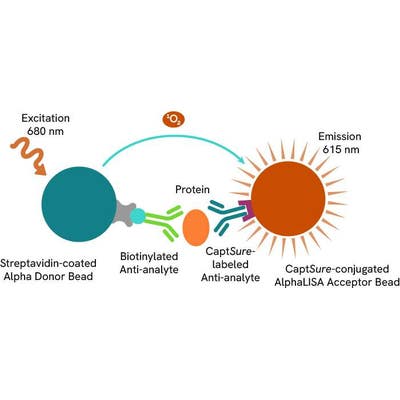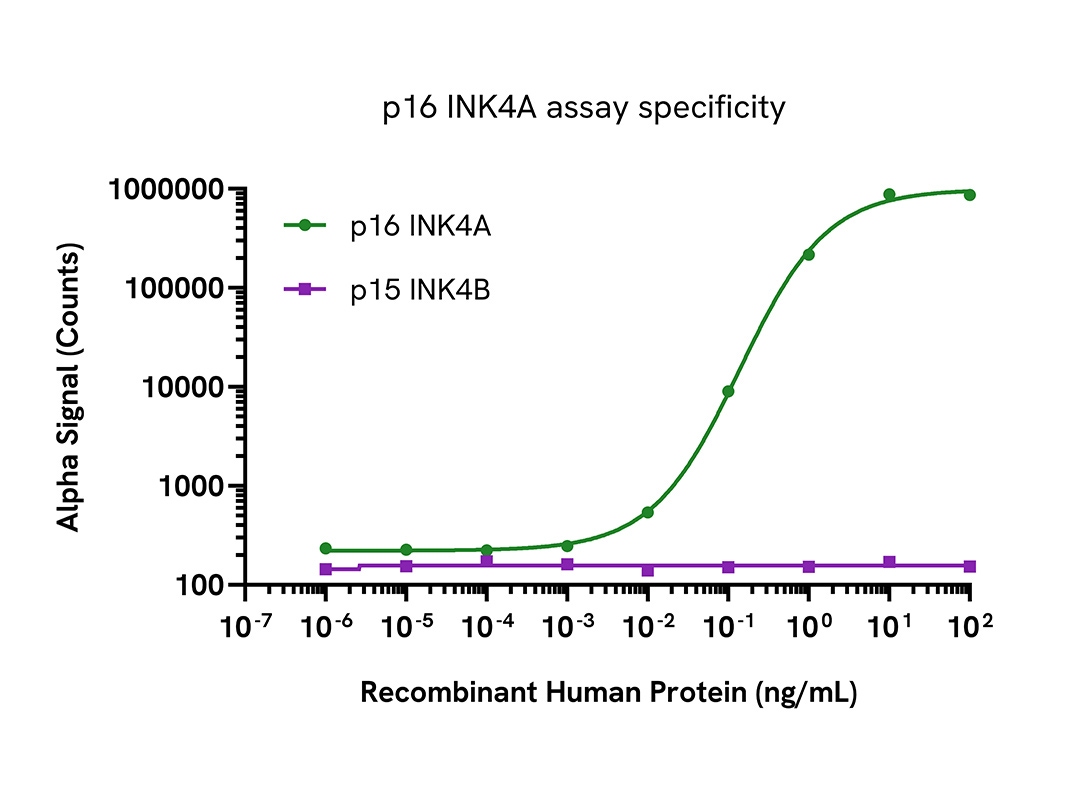

AlphaLISA SureFire Ultra Human Total p16 INK4A Detection Kit, 10,000 Assay Points

AlphaLISA SureFire Ultra Human Total p16 INK4A Detection Kit, 10,000 Assay Points




The AlphaLISA™ SureFire® Ultra™ Human Total p16 INK4A assay is a sandwich immunoassay for quantitative detection of total p16 INK4A in cellular lysates using Alpha Technology.
For research use only. Not for use in diagnostic procedures. All products to be used in accordance with applicable laws and regulations including without limitation, consumption and disposal requirements under European REACH regulations (EC 1907/2006).
| Feature | Specification |
|---|---|
| Application | Protein Quantification |
The AlphaLISA™ SureFire® Ultra™ Human Total p16 INK4A assay is a sandwich immunoassay for quantitative detection of total p16 INK4A in cellular lysates using Alpha Technology.
For research use only. Not for use in diagnostic procedures. All products to be used in accordance with applicable laws and regulations including without limitation, consumption and disposal requirements under European REACH regulations (EC 1907/2006).


AlphaLISA SureFire Ultra Human Total p16 INK4A Detection Kit, 10,000 Assay Points


AlphaLISA SureFire Ultra Human Total p16 INK4A Detection Kit, 10,000 Assay Points


Product information
Overview
Cyclin-dependent kinase inhibitor 2A (p16 INK4A) is a tumor suppressor protein that inhibits cyclin-dependent kinases 4 and 6 (CDK4/6), thereby regulating the cell cycle by preventing the phosphorylation of retinoblastoma protein (Rb). This action halts cell cycle progression from the G1 to the S phase, thereby inhibiting cellular proliferation. Mutations or deletions in the p16 INK4A gene are associated with several cancers, including melanoma, pancreatic cancer, and head and neck cancers. Elevated levels of p16 INK4A have been also observed in neurodegenerative diseases like Alzheimer’s, where it may contribute to the loss of neuronal function and cognitive decline.
The AlphaLISA SureFire Ultra Human Total p16 INK4A Detection Kit is a sandwich immunoassay for the quantitative detection of total p16 INK4A in cellular lysates, using Alpha Technology.
Formats:
- The HV (high volume) kit contains reagents to run 100 wells in 96-well format, using a 60 μL reaction volume.
- The 500-point kit contains enough reagents to run 500 wells in 384-well format, using a 20 μL reaction volume.
- The 10,000-point kit contains enough reagents to run 10,000 wells in 384-well format, using a 20 μL reaction volume.
- The 50,000-point kit contains enough reagents to run 50,000 wells in 384-well format, using a 20 μL reaction volume.
AlphaLISA SureFire Ultra kits are compatible with:
- Cell and tissue lysates
- Antibody modulators
- Biotherapeutic antibodies
Alpha SureFire Ultra kits can be used for:
- Cellular kinase assays
- Receptor activation studies
- Screening
Specifications
| Application |
Protein Quantification
|
|---|---|
| Automation Compatible |
Yes
|
| Brand |
AlphaLISA SureFire Ultra
|
| Detection Modality |
Alpha
|
| Host Species |
Human
|
| Molecular Modification |
Total
|
| Product Group |
Kit
|
| Shipping Conditions |
Shipped in Blue Ice
|
| Target |
p16 INK4A
|
| Target Class |
Phosphoproteins
|
| Target Species |
Human
|
| Technology |
Alpha
|
| Therapeutic Area |
Oncology
|
| Unit Size |
10,000 Assay Points
|
How it works
Total-AlphaLISA SureFire Ultra assay principle
The Total-AlphaLISA SureFire Ultra assay measures the expression level of a protein target in a cell lysate.
The Total-AlphaLISA SureFire Ultra assay uses two antibodies which recognize two different distal epitopes on the targeted protein. AlphaLISA assays require two bead types: Acceptor and Donor beads. Acceptor beads are coated with a proprietary CaptSure™ agent to specifically immobilize the assay specific antibody, labeled with a CaptSure™ tag. Donor beads are coated with streptavidin to capture one of the detection antibodies, which is biotinylated. In the presence of targeted protein, the two antibodies bring the Donor and Acceptor beads in close proximity whereby the singlet oxygen transfers energy to excite the Acceptor bead, allowing the generation of a luminescent Alpha signal. The amount of light emission is directly proportional to the quantity of protein present in the sample.

Total-AlphaLISA SureFire Ultra two-plate assay protocol
The two-plate protocol involves culturing and treating the cells in a 96-well plate before lysis, then transferring lysates into a 384-well OptiPlate™ plate before the addition of Total-AlphaLISA SureFire Ultra detection reagents. This protocol permits the cells' viability and confluence to be monitored. In addition, lysates from a single well can be used to measure multiple targets.

Total-AlphaLISA SureFire Ultra one-plate assay protocol
Detection of Total target protein with AlphaLISA SureFire Ultra reagents can be performed in a single plate used for culturing, treatment, and lysis. No washing steps are required. This HTS designed protocol allows for miniaturization while maintaining AlphaLISA SureFire Ultra quality.

Assay validation
Increase of total p16 INK4A levels in Palbociclib treated cells
HEK293 cells were seeded in a 96-well plate (10,000 cells/well) in complete medium, and incubated overnight at 37°C, 5% CO2. The cells were treated with 10 µM of Palbociclib for 24 hours. After treatment, the cells were lysed with 100 µL of Lysis Buffer for 10 minutes at RT with shaking (350 rpm). Lysates were further diluted 1:50 in Lysis Buffer before proceeding to the detection step. Total p16 INK4A levels were evaluated using AlphaLISA SureFire Ultra assay kit.
For the detection step, 10 µL of cell lysate (approximately 20 cells) were transferred into a 384-well white OptiPlate, followed by 5 µL of Acceptor mix and incubated for 1 hour at RT. Finally, 5 µL of Donor mix was then added to each well and incubated for 1 hour at RT in the dark. The plate was read on an Envision using standard AlphaLISA settings.
Palbociclib triggered an increase in Total p16 INK4A levels in HEK293 cells. Total Cofilin levels remain unchanged (data not shown).

Assay specificity/selectivity
Specificity of total p16 INK4A assay
Specificity of the Total p16 INK4A assay was assessed by assaying recombinant p16 INK4A and p15 INK4b protein. Dilutions of recombinant human p16 INK4A (Abcam, ab84075) and p15 INK4B (Abcam, ab268830) proteins were prepared in Lysis Buffer. p16 INK4A Total levels were evaluated using the AlphaLISA SureFire Ultra assay.
For the detection step, 10 µL of protein was transferred into a 384-well white OptiPlate, followed by 5 µL of Acceptor mix and incubated for 1 hour at RT. Finally, 5 µL of Donor mix was then added to each well and incubated for 1 hour at RT in the dark. The plate was read on an Envision using standard AlphaLISA settings.
Total p16 INK4A assay was specific only to p16 INK4A recombinant protein with no signal detected with p15 INK4B recombinant protein. This result demonstrates the specificity of the Total p16 INK4A AlphaLISA SureFire Ultra assay as these two proteins share more than 80 % sequence identity.

Assay versatility
Differential expression of p16 INK4A total in various human cell lines
Human cell lysates were diluted with Lysis Buffer. Approximate number of cells/datapoint is indicated on graph. Total p16 INK4A levels were evaluated using the AlphaLISA SureFire Ultra assay kit. For the detection step, 10 µL of cell lysate was transferred into a 384-well white OptiPlate, followed by 5 µL of Acceptor Mix and incubated for 1 hour at RT. Finally, 5 µL of Donor Mix was then added to each well and incubated for 1 hour at RT in the dark. The plate was read on an Envision using standard AlphaLISA settings.
Total p16 INK4A expression is dependent upon cell type. As expected, a very high level of expression was detected in HEK293 and HeLa cells, with lower expression in Hep G2, SH-SY5Y and BeWo cells.

Resources
Are you looking for resources, click on the resource type to explore further.


How can we help you?
We are here to answer your questions.






























